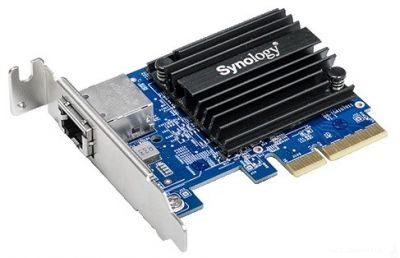Synology NAS and the New 10GBe PCIe Upgrade Cards E10G18-T1 and E10G18-T2
Good news for any Synology NAS owner with a PCIe slot and a need to upgrade to 10GBe. Today we want to discuss the new E10G18-T1 and E10G18-T2 upgrade cards from Synology that will allow you to add one or two 10 Gigabit Ethernet ports (respectively) to your PCIe enabled NAS. This year is fast becoming the turning point when 10G networking and direct NAS access has broken into the home and SMB market. It is understandable, with the max abilities of standard 1Gbe RJ45 LAN becoming the bottleneck for most users, it can be very attractive indeed to upgrade your NAS to the 10x faster network connectivity. This is especially attractive to users that wish to edit files DIRECTLY On the NAS (photo and video editing for example) either by connecting their system via a 10Gbe switch to a 10G NAS, or just cutting out the middleman and directly connecting to the 10GBe NAS and removing any trace of that pesky bottleneck! But 10Gbe isn’t a new concept and has actually been around for many years, so why is this such a big deal now and why should you care about the E10G18-T1 and E10G18-T2? Find out below.
Why should you care about the Synology E10G18-T1 and E10G18-T2?
Synology has released numerous NAS devices over the last 5 years that arrive with an available PCIe slot. This (as it is with a desktop PC) is to allow the user to upgrade the connection of their NAS to one that is faster or better suited to the network environment it will live in. Although there are several official Synology PCIe cards that can be used in this slot (the M2D17 and M2D18 Cache cards for example), most commonly the upgrade to 10Gbe via this port is the most frequent choice. What makes the E10G18-T1 and E10G18-T2 10GBe cards appealing is three main reasons below:
The Synology E10G18-T1 and E10G18-T2 cards use 10GBASE-T
10 Gigabit Ethernet is most commonly available in two different formats, SFP (fiber optic cables) and 10GBASE-T (Copper cables). Both have their own advantages and disadvantages (see article below) but in short, SFP+ is used for much, much further distances, is much more expensive to install, requires transceivers at either end of cables and is generally used by enterprise or data centers. 10GBASE-T is the option for those that want 10Gbe, covering a smaller area (no cable should exceed 15-20m), want to mix 1Gbe and 10Gbe (as 10Gbe is backwards compatible and identical in design to bog standard RJ45) and want to spend much less (as its waaaay cheaper overall). Synology have dabbled with 10GBASE-T NAS and PCIe before with varying degrees of success and in fact have a desktop 10Gbe NAS in the form of the DS1817, however, it met with mixed results as they tend to leverage the internal hardware on these NAS towards mid power processors/memory. However, the E10G18-T1 and E10G18-T2 cards let you upgrade NAS with more powerful Celeron, Pentium and Xeon CPU to have an external speed that can match the internal throughput.
Should you Choose 10GBASE-T Copper Over SFP+ for 10G Ethernet
The Synology E10G18-T1 and E10G18-T2 arrive with the Aquantia controller
Both the single port E10G18-T1 is equipped with the Aquantia AQtion AQC107 NIC controller that supports 10/5/2.5/1Gbps and 100Mbps speeds. This leverages the industry-leading Aquantia NBASE-T solution (which is growing especially popular in NAS in 2018) and marrying that with the hardware on your Synology NAS very well indeed. Additionally, although this is yet to be confirmed officially, this controller should mean that this PCIe 10Gbe range of cards will be compatible with Windows and Linux PCs, as well as Synology NAS
EDITED:
E10G18-T1
- IEEE 802.3x Flow Control
- IEEE 802.3u Fast Ethernet
- IEEE 802.3ab Gigabit Ethernet
- IEEE 802.3bz 2.5Gbps / 5Gbps Ethernet
- IEEE 802.3an 10Gbps Ethernet
E10G18-T2
- IEEE 802.3x Flow Control
- IEEE 802.3ad Link Aggregation
- IEEE 802.3ab Gigabit Ethernet
- IEEE 802.3an 10Gbps Ethernet
The Synology E10G18-T1 and E10G18-T2 are supported by pretty much any Synology NAS with PCIe, new or old
Both the E10G18-T1 and E10G18-T2 cards have a PCIe 3.0 x4 which is both common on Synology NAS and backwards compatible too. This means that even old NAS such as 2011 released DS3611xs or the incredible new DS1819+ will support this card. It will act as an inexpensive means to either remove the bottleneck on a modern NAS, or even arrange a 10x faster network backup onto your old NAS. Below are NAS that will are compatible with the E10G18-T1 and E10G18-T2 Synology 10Gbe cards:
- DS3611xs
- DS3612xs
- DS3615xs
- RS10613xs+
- RS18016xs+
- RS3411RPxs+
- RS3412RPxs
- RS3413xs+
- RS3614RP+
- RS3614xs+
- DS1517+
- DS1817+
- FS2017
- RS18017xs+
- RS3617RPxs
- RS3617xs
- RS4017xs+
- DS1618+
- FS1018
- RS2818RP+
- RS818RP+
- RS2418RP+
- DS1819+
- DS2419+
- RS1219+
This description contains links to Amazon. These links will take you to some of the products mentioned in today’s video. As an Amazon Associate, I earn from qualifying purchases

